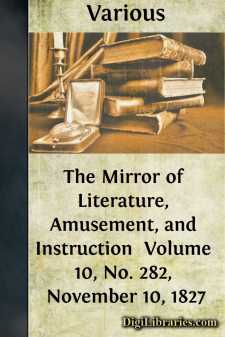Categories
- Antiques & Collectibles 13
- Architecture 36
- Art 48
- Bibles 22
- Biography & Autobiography 813
- Body, Mind & Spirit 142
- Business & Economics 28
- Children's Books 16
- Children's Fiction 13
- Computers 4
- Cooking 94
- Crafts & Hobbies 4
- Drama 346
- Education 46
- Family & Relationships 57
- Fiction 11829
- Games 19
- Gardening 17
- Health & Fitness 34
- History 1377
- House & Home 1
- Humor 147
- Juvenile Fiction 1873
- Juvenile Nonfiction 202
- Language Arts & Disciplines 88
- Law 16
- Literary Collections 686
- Literary Criticism 179
- Mathematics 13
- Medical 41
- Music 40
- Nature 179
- Non-Classifiable 1768
- Performing Arts 7
- Periodicals 1453
- Philosophy 64
- Photography 2
- Poetry 896
- Political Science 203
- Psychology 42
- Reference 154
- Religion 513
- Science 126
- Self-Help 84
- Social Science 81
- Sports & Recreation 34
- Study Aids 3
- Technology & Engineering 59
- Transportation 23
- Travel 463
- True Crime 29
The Mirror of Literature, Amusement, and Instruction Volume 10, No. 282, November 10, 1827
by: Various
Categories:
Description:
Excerpt
HANOVER TERRACE, REGENT'S PARK.
"The architectural spirit which has arisen in London since the late peace, and ramified from thence to every city and town of the empire, will present an era in our domestic history." Such is the opinion of an intelligent writer in a recent number of Brande's "Quarterly Journal;" and he goes on to describe the new erections in the Regent's Park as the "dawning of a new and better taste, and in comparison with that which preceded it, a just subject of national exultation;" in illustration of which fact we have selected the subjoined view of Hanover Terrace, being the last group on the left of the York-gate entrance, and that next beyond Sussex-place, distinguishable by its cupola tops.
Hanover Terrace, unlike Cornwall and other terraces of the Regent's Park, is somewhat raised from the level of the road, and fronted by a shrubbery, through which is a carriage-drive. The general effect of the terrace is pleasing; and the pediments, supported on an arched rustic basement by fluted Doric columns, are full of richness and chaste design; the centre representing an emblematical group of the arts and sciences, the two ends being occupied with antique devices; and the three surmounted with figures of the Muses. The frieze is also light and simply elegant. The architect is Mr. Nash, to whose classic taste the Regent's Park is likewise indebted for other interesting architectural groups.
Altogether, Hanover Terrace may be considered as one of the most splendid works of the neighbourhood, and it is alike characteristic of British opulence, and of the progressive improvement of national taste. On the general merits of these erections we shall avail ourselves of the author already quoted, inasmuch as his remarks are uniformly distinguished by moderation and good taste.
"Regent's Park, and its circumjacent buildings, promise, in few years, to afford something like an equipoise to the boasted Palace-group of Paris. If the plan already acted upon is steadily pursued, it will present a union of rural and architectural beauty on a scale of greater magnificence than can be found in any other place. The variety is here in the detached groups, and not as formerly in the individual dwellings, by which all unity and grandeur of effect was, of course, annihilated. These groups, undoubtedly, will not always bear the eye of a severe critic, but altogether they exhibit, perhaps, as much beauty as can easily be introduced into a collection of dwelling-houses of moderate size. Great care has been, taken to give something of a classical air to every composition; and with this object, the deformity of door-cases has been in most cases excluded, and the entrances made from behind. The Doric and Ionic orders have been chiefly employed; but the Corinthian, and even the Tuscan, are occasionally introduced. One of these groups is finished with domes; but this is an attempt at magnificence which, on so small a scale, is not deserving of imitation."
(To the Editor of the Mirror.)
SIR,—Under the Arcana of Science, in your last Number, I observed an account of the inroads made by the sea on the Isle of Sheppey, together with the exhumation there of numerous animal and vegetable remains....












